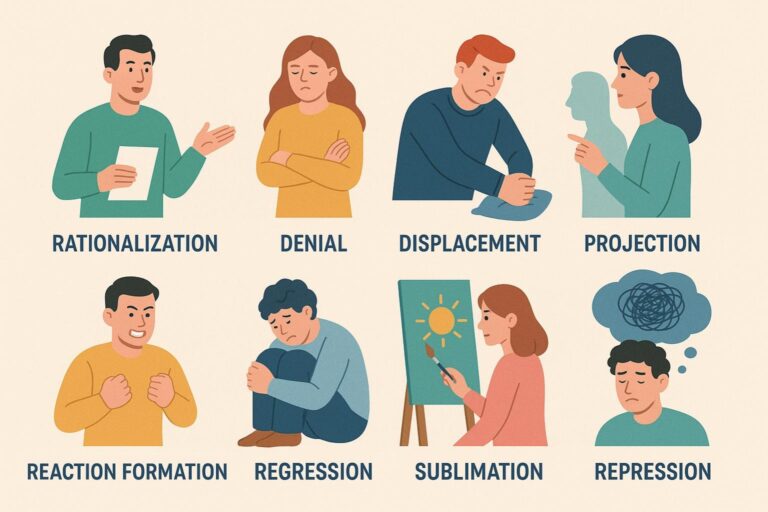Id, Ego, and Superego: Freud’s Model of Personality and the Mind

Quick Summary
Freud’s structural model of the mind divides personality into three key parts: the id, ego, and superego. These components interact constantly, often unconsciously, to influence thoughts, behavior, and internal conflict. The id seeks pleasure, the ego balances reality, and the superego enforces moral values. When these forces clash, the ego uses defense mechanisms to protect the mind. This model is a core part of Freud’s broader theory of psychoanalysis.
1. What Is Freud’s Structural Model of the Mind?
Sigmund Freud introduced the structural model of the psyche in 1923 to explain how internal psychological forces interact and shape human behavior. He proposed that the mind is divided into three interacting parts:
- The id, which holds unconscious drives and instincts
- The ego, which manages reality and decision-making
- The superego, which represents internalized morals and ideals.[1]
These components function together but are often in conflict. Freud believed that understanding this internal struggle was essential to explaining anxiety, personality development, and mental distress. The model remains a core feature of psychoanalysis, Freud’s broader theory of the unconscious mind.
2. The Id: Instincts and Impulses
The id is the most basic and instinctual part of the mind. Present from birth, it operates entirely in the unconscious and is guided by the pleasure principle: the desire to satisfy needs and urges immediately, regardless of reality or social norms.[1]
The id contains biological drives such as hunger, sex, and aggression. It is irrational, emotional, and selfish, focused on relieving discomfort and seeking pleasure through what Freud called primary process thinking.
Example: A person stuck in traffic feels a strong urge to cut others off or honk aggressively out of frustration. This reflects the id’s demand for immediate gratification, without considering the rules or consequences.
In adulthood, id impulses continue to influence thoughts and behaviors. These urges are often kept in check by the ego or suppressed through defense mechanisms.
3. The Ego: Reality and Mediation
The ego develops during early childhood as the person begins to interact with the world. It operates partly in the conscious mind and is guided by the reality principle: the ability to delay gratification, plan ahead, and evaluate consequences.[2]
The ego acts as a mediator, balancing the demands of the id and superego with the practical limitations of reality. It uses secondary process thinking, which is rational and logical.
Example: A person feels the impulse to criticize a coworker during a meeting (id) but holds back to maintain professionalism. Instead, they decide to give feedback privately later. This solution reflects the ego’s ability to find a realistic and socially appropriate compromise.
The ego does not aim for pleasure or moral perfection. Its role is to maintain psychological balance by managing internal desires and external expectations. A healthy ego supports decision-making, emotional regulation, and realistic self-perception.
4. The Superego: Morality and Ideals
The superego develops as the child internalizes values and expectations from parents, authority figures, and culture. It acts as the mind’s moral guide and holds ideals about how one should behave.[1]
It has two main parts:
- The conscience, which punishes misbehavior with guilt or shame
- The ego ideal, which rewards ethical conduct with pride or self-approval.[2]
Example: A person who avoids taking credit for someone else’s work, even if they would benefit from it, may be guided by their superego’s commitment to fairness.
A strong but flexible superego promotes responsible behavior and self-respect. However, if it becomes too rigid, it may lead to harsh self-judgment, perfectionism, and chronic guilt.
5. Interaction of the Id, Ego, and Superego
Freud viewed personality as the result of constant tension and negotiation between the id, ego, and superego. These parts of the psyche are always interacting, each with different goals:
- The id demands immediate satisfaction
- The superego imposes ideals and moral judgment
- The ego finds a realistic and acceptable way to meet both.[1]
Example: A person sees an expensive item they want but cannot afford.
- The id urges them to take it.
- The superego warns that stealing is wrong.
- The ego weighs the options and decides to save up and purchase it later.
When the ego successfully mediates, the person behaves in a balanced and adaptive way. However, conflict is inevitable. The id may generate impulses the superego condemns, and the ego must constantly manage this tension.
If the internal pressure becomes too great, the ego activates defense mechanisms to avoid being overwhelmed. These defenses are a natural part of this interaction and emerge when rational compromise is no longer enough to maintain internal stability.
6. Why Internal Conflict Triggers Defense Mechanisms
When the ego cannot find a realistic way to satisfy both the id and the superego, emotional discomfort often arises. This may take the form of anxiety, guilt, or shame.[3]
To reduce this distress, the ego unconsciously uses defense mechanisms: psychological strategies that distort, block, or redirect unacceptable thoughts and feelings. These defenses help the person function in the face of emotional conflict, though they often operate without awareness.
Example: A teenager angry at a strict parent may redirect their anger toward a friend or sibling. This is called displacement, a common defense that protects the ego from guilt.
Commonly used defenses include:
- Repression: Hiding distressing thoughts from consciousness
- Denial: Refusing to accept painful truths
- Projection: Attributing one’s own feelings to someone else
- Displacement: Redirecting emotions from a threatening target to a safer one
- Rationalization: Creating acceptable explanations for unacceptable behavior
These defenses can be helpful in the short term. However, if used habitually or rigidly, they may interfere with emotional growth or relationships.
Defense mechanisms are the ego’s way of coping with conflict between the id and superego. They help manage distress, but they are not always effective in resolving the underlying issues. That is why therapy is often needed, not just to reduce symptoms, but to help individuals become aware of their inner conflict and learn healthier ways to cope and grow.
7. What Happens When Conflict Arises?
Conflict among the id, ego, and superego is a normal part of life, and defense mechanisms are often the ego’s first line of protection. But if defenses are ineffective or overused, psychological symptoms may emerge.[3]
Example: A person who constantly apologizes and feels guilty after asserting themselves may have a harsh superego and a fragile ego, leading to internal conflict and chronic anxiety.
Therapy can help by:
- Making unconscious conflicts conscious
- Identifying overused defenses
- Strengthening the ego so it can mediate conflict more effectively
Defense mechanisms can ease tension temporarily. However, they do not always resolve deeper psychological struggles. That’s why therapy is important: not to remove defenses, but to understand their purpose and uncover the conflicts beneath them.
8. What If There’s an Imbalance?
A healthy personality, in Freud’s view, depends on a balanced relationship among the id, ego, and superego.[4] Conflict is always present, but imbalance occurs when the ego is unable to manage that conflict in a stable and flexible way.
In these situations, the ego often resorts to defense mechanisms to protect the person from being overwhelmed. While these mechanisms can reduce anxiety in the short term, they do not always resolve the underlying problem. If the ego becomes too dependent on defenses, or if those defenses are too rigid or immature, the person may experience persistent distress, behavioral issues, or difficulty functioning.
Example: A person who constantly avoids social situations may unconsciously fear criticism (superego) while still craving connection (id). If the ego cannot manage this inner tension constructively, it may rely on denial or avoidance, which brings temporary relief but worsens the problem over time.
In these cases, defense mechanisms are no longer enough. The imbalance becomes more apparent. Therapy helps by strengthening the ego, making inner conflict conscious, and fostering healthier ways to respond.
9. How This Is Used in Therapy
Freud’s structural model remains influential in psychodynamic therapy, which focuses on how unconscious conflict shapes behavior, thoughts, and emotional patterns.[5]
When inner conflict becomes overwhelming, therapy helps by exploring the root causes of distress and providing tools to manage it more consciously. Therapists draw on the structural model to work with the client’s ego, id, and superego in different ways.
Strengthening the Ego
A major therapeutic goal is to help strengthen the ego so that it can mediate inner conflict more effectively. A stronger ego is better able to balance desires and moral expectations, delay gratification, and cope with stress without overusing defenses.
Example: A person who avoids confrontation may discover that their behavior comes from a fear of disapproval. In therapy, they learn to express themselves assertively, tolerating discomfort without feeling overwhelmed. This shift reflects a more resilient and capable ego.
Challenging a Harsh Superego
In some cases, the superego is too rigid, producing constant guilt, shame, or self-criticism. Therapy can help challenge and relax the superego by examining where these moral messages came from and whether they are realistic or fair.
Example: A client who feels guilty for taking time off work may explore early messages about productivity and self-worth. With the therapist’s support, they learn to internalize more compassionate standards, reducing guilt and allowing for healthier self-care.
Other Therapeutic Goals
Aside from working directly with the ego and superego, therapists also help clients to:
- Identify overused defense mechanisms
- Explore the origins of emotional patterns
- Gain insight into past experiences that shape the present
- Develop a more coherent and realistic sense of self
While modern therapists often integrate cognitive, behavioral, and humanistic methods, Freud’s idea that unconscious conflict underlies much of our emotional life still provides a valuable framework for understanding change and healing.
10. Criticisms and Limitations
Freud’s theory has had a major influence on psychology but is not without criticism:
- Scientific limitations: The model is difficult to test or measure objectively[6]
- Overemphasis on conflict and sexuality: Critics argue that Freud downplayed growth, creativity, and conscious decision-making
- Cultural and gender bias: Some ideas reflect early 20th-century norms and may not apply universally
Even so, the id–ego–superego model remains a powerful framework for understanding internal struggle, motivation, and emotional development.
References
- Freud, S. (1961). The ego and the id. In J. Strachey (Ed. & Trans.), The standard edition of the complete psychological works of Sigmund Freud (Vol. 19, pp. 12–66). Hogarth Press. (Original work published 1923)
- Burger, J. M. (2019). Personality (10th ed.). Cengage Learning.
- Cramer, P. (2015). Understanding defense mechanisms. Psychodynamic Psychiatry, 43(4), 523–552. https://doi.org/10.1521/pdps.2015.43.4.523
- Boag, S. (2006). Freudian repression, the common view, and pathological science. Review of General Psychology, 10(1), 74–86. https://doi.org/10.1037/1089-2680.10.1.74
- Lemma, A. (2016). Introduction to the practice of psychoanalytic psychotherapy (2nd ed.). Wiley-Blackwell.
- Westen, D. (1998). The scientific legacy of Sigmund Freud: Toward a psychodynamically informed psychological science. Psychological Bulletin, 124(3), 333–371. https://doi.org/10.1037/0033-2909.124.3.333





